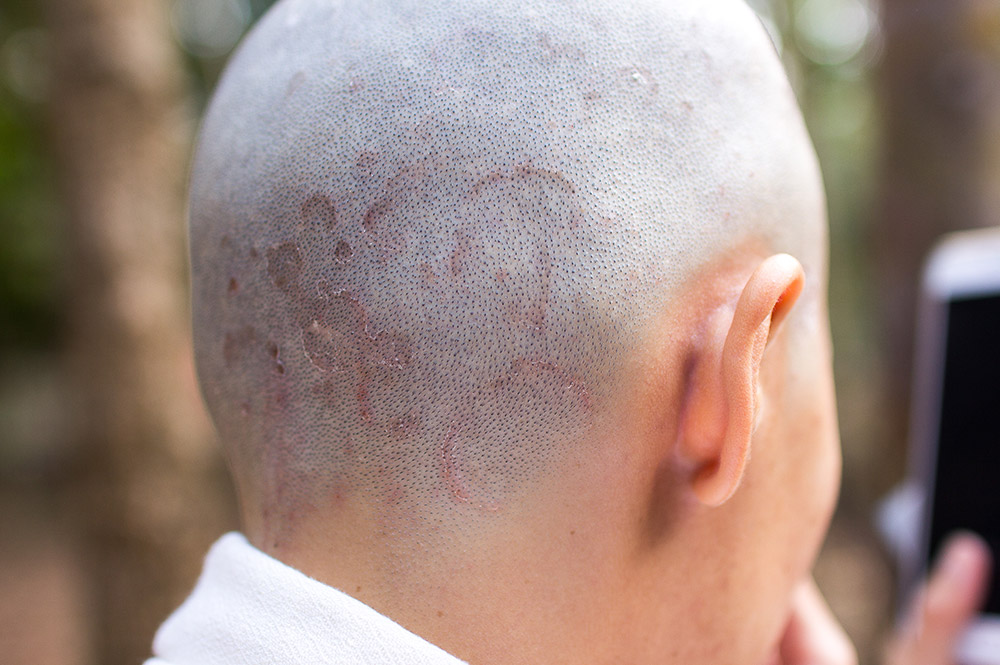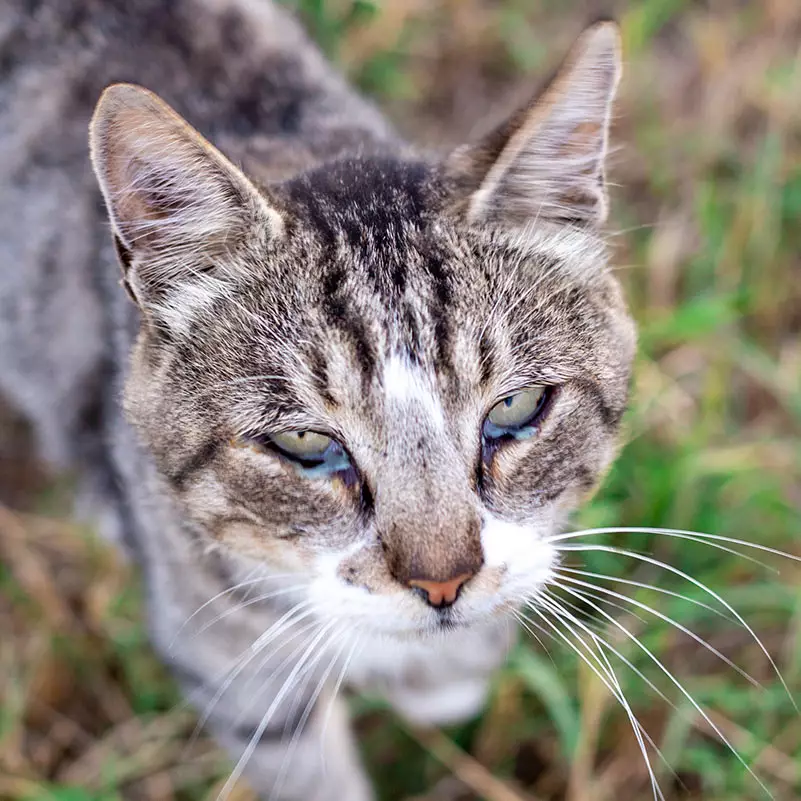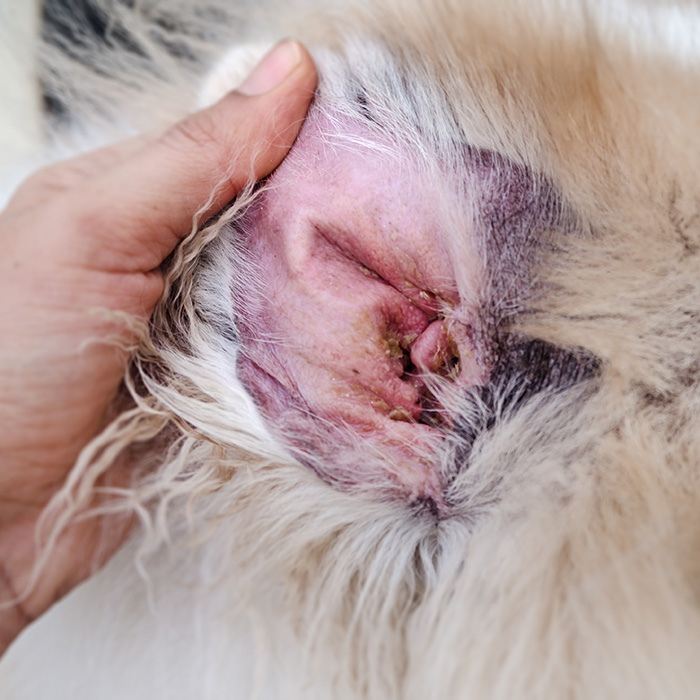Ringworm in dogs and cats
What is ringworm?
The term “ringworm” can elicit much anxiety and confusion amongst pet owners, and rightly so. Is it a type of worm, a fungal infection or just itchy skin? On the plus side, all thoughts of worms can be dispelled immediately; ringworm is not caused by a worm and has nothing to do with worms at all.
 Ringworm is, in fact, a common skin infection of the outer layers of the skin, hair and nails that is caused by a fungus. The name derives from the classic appearance of a circular, raised ‘ring’ surrounding a patch of inflammation. However, the infected areas are not always ring-shaped.
Ringworm is, in fact, a common skin infection of the outer layers of the skin, hair and nails that is caused by a fungus. The name derives from the classic appearance of a circular, raised ‘ring’ surrounding a patch of inflammation. However, the infected areas are not always ring-shaped.
A group of fungi called dermatophytes cause ringworm; hence the medical term “dermatophytosis” for the condition. These fungi feed on the keratin that is found in the outer layers of the skin, hair, and nails. Ringworm infections can occur in humans and in all domesticated species of animals.
Ringworm in dogs
The three most common fungal species that cause ringworm in dogs are Microsporum canis, Microsporum gypseum and Trichophyton mentagrophytes. These fungi are all zoonotic, meaning they can spread between animals and humans.
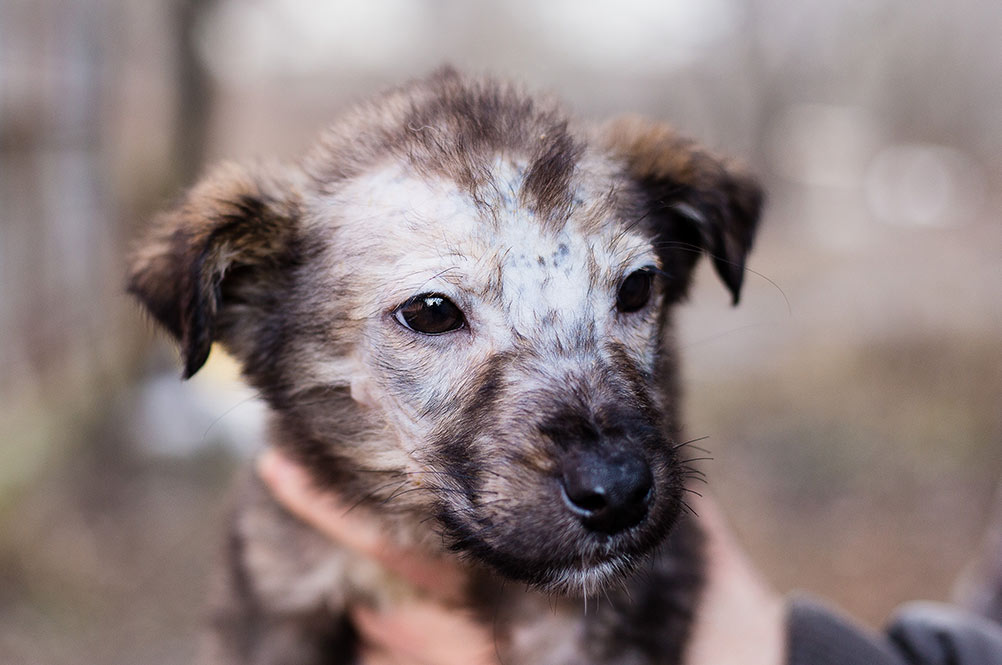
Ringworm in cats
The Microsporum canis fungus is responsible for almost all ringworm infections in cats. Microsporum canis is also infectious to dogs and humans, being able to spread between different species. Occasionally, ringworm in cats is caused by another type of dermatophyte, such as Trichophyton mentagrophytes.
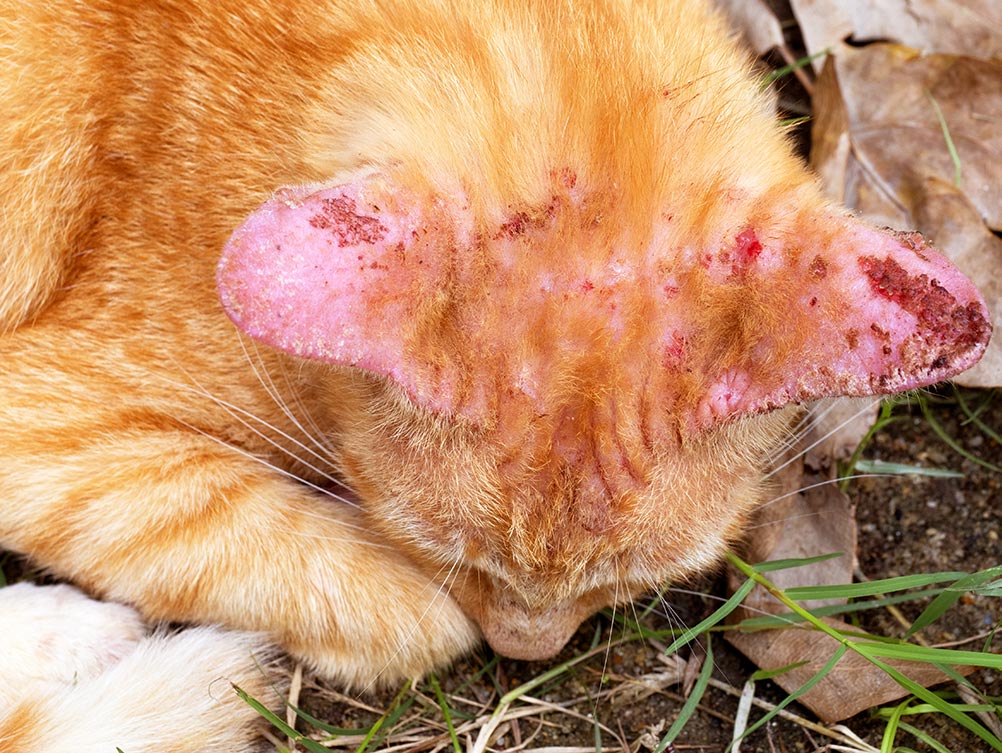
How is ringworm transmitted?
Ringworm is a contagious fungal infection which is transmitted when the skin comes into contact with the spores of the fungus. Spores are microscopic particles that enable fungi to reproduce; they are commonly found in the soil and on the skin and hair.
How do dogs get ringworm?
Ringworm in dogs occurs via direct contact with an infected animal or person, contaminated objects or contaminated surfaces. The fungal spores may remain dormant on grooming equipment, food bowls, furniture, bedding, flooring or other environmental surfaces for many months (reportedly up to 18 months).
Puppies less than a year old are the most vulnerable, and the infection can spread quickly amongst dogs in a kennel or to other dogs in the home.
How do cats get ringworm?
As with dogs, ringworm in cats is acquired through direct contact with the spores of the fungus. These may be present in the soil, on the skin of an infected animal or person, or on a contaminated object or surface.
The fungi that cause ringworm are commonly found on cats. The spores can be present on a cat even when it shows no symptoms.
Can you get ringworm from dogs and cats?
Yes! Ringworm can be transmitted to humans via a number of sources including the soil, other people or by touching an infected animal. In fact, ringworm is one of the few infections that can be transferred from animals to humans.
As the fungi can live on stray hair follicles and skin cells, ringworm is fairly easily transmitted. One species of ringworm, Microsporum gypseum, is found in the soil and can be picked up by spending time in the garden.
Ringworm is highly contagious to humans, with children, the elderly and anyone with a compromised immune system or skin sensitivity being particularly susceptible to infection. However, contact with ringworm fungus does not always result in an infection. The extent of environmental contamination is an important factor, as is the age and health of the exposed person or animal. Healthy adults are usually resistant unless they have a scratch or other break in the skin.
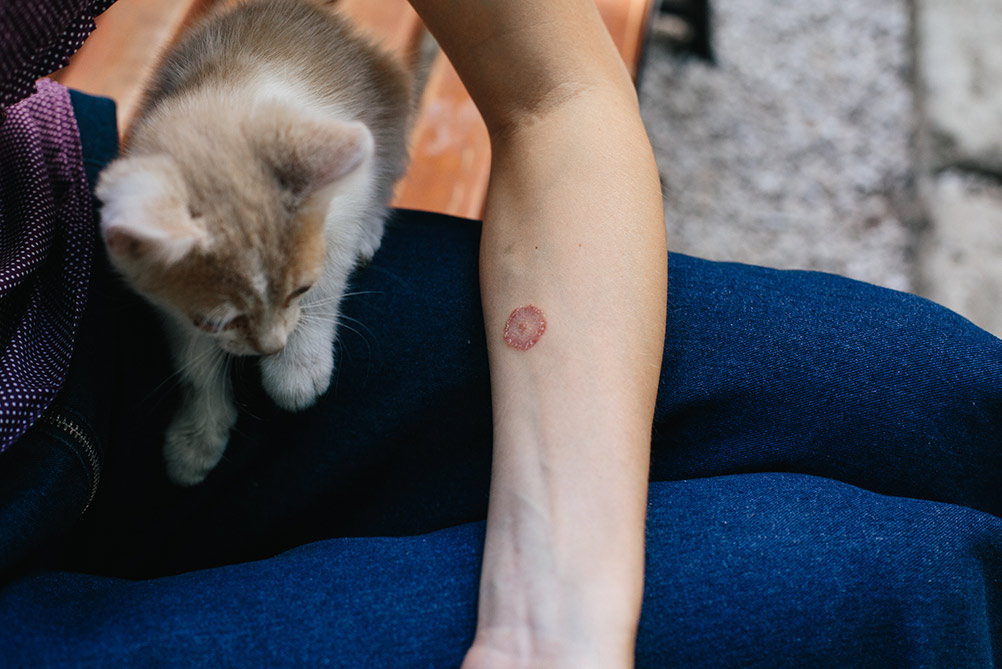
A pet insurance policy with Bow Wow Meow will help ensure you can always afford to give your pet the best treatment.
What does ringworm look like? Symptoms of ringworm in dogs, cats and humans!
Symptoms of ringworm in dogs
Ringworm in dogs often appears as round patches of hair loss, often occurring on a dog’s head, paws, ears, and forelegs. Hair loss occurs because the fungi infect the hair follicles, causing them to become fragile and to break off easily at the skin line. As the fungi multiply, the lesions spread across the dog’s body, typically becoming larger and more irregular in shape, and the hairs in the centre regrow.
Lesions occurring under a dog’s fur may be difficult to see. In mild cases, there may be no symptoms of ringworm in dogs at all. However, in more serious cases, the following symptoms may be evident:
- Several circular patches of hair loss (alopecia)
- Irregularly shaped patches of hair loss scattered over the body
- Scaly, crusty, thick and red patches of skin
- Inflammation and scabby patches covering or surrounding a lesion
- Dandruff-like scaling within the coat
- Itchy skin at the site of the infection
- Rough, brittle and broken claws (onychomycosis)
Symptoms of ringworm in cats
In cats, the main sites where lesions may appear are on the head, chest, forelegs, and along the ridge of the back. These lesions are usually not itchy. However, ringworm in cats can be challenging to spot, because the lesions may be very mild or even undetectable. In more serious cases, the following symptoms may be evident:
- Scaling in the depths of the coat
- Round, thickened patches of skin with hair loss
- Patchy hair loss over a large area of the body
- Rough, pitted and deformed claws (onychomycosis)
Longhaired breeds in particular may have ringworm without any signs or symptoms of the condition. These cats are called ‘asymptomatic carriers’; they may infect other animals or people, especially in shelters or multi-cat environments, without caregivers knowing they are infected.
Symptoms of ringworm in humans
In people, ringworm typically appears as a red, scaly, itchy skin lesion with a ring-like appearance. The inside of the patch may be clear or scaly, while the outside may be raised and bumpy. It can occur on the scalp, face, groin, feet, nails or other areas of the body. Symptoms can vary depending on the location of the infection, but typically include:
- Red, itchy or scaly patches (raised areas of skin)
- Blisters or pustules on the lesions
- Reddish, ring-like appearance to the outside edges of the lesions
- Raised, defined edges of the lesions
- Thick, discoloured, cracked nails
- Hair loss and bald patches on the scalp
How to diagnose ringworm in dogs and cats
Because it is highly contagious, if you suspect your dog or cat has ringworm it is important to seek veterinary treatment immediately. Diagnosis often requires a detailed clinical examination and testing.
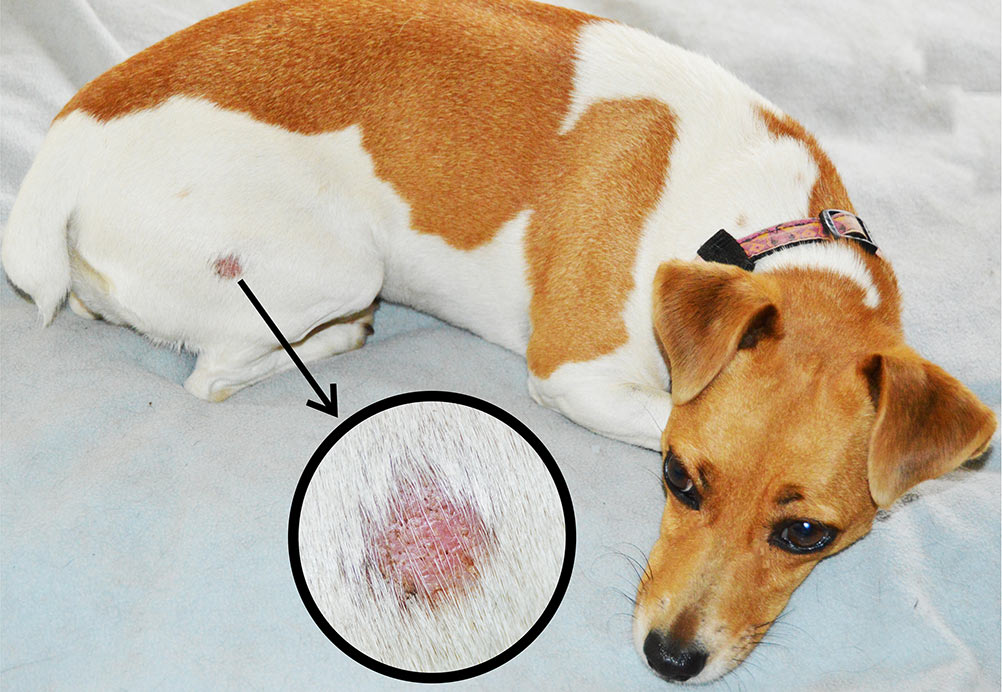
Your vet may use a combination of the following diagnostic tests:
Physical examination
Your vet will thoroughly examine your pet’s skin for the typical skin lesions and scaling that occur with ringworm. This method is not very accurate and may lead to misdiagnosis. Additional diagnostic tests are usually necessary to confirm if ringworm fungi are present.
Wood’s Lamp
This is a special ultraviolet lamp that shows a yellow-green fluorescent glow of the infected hairs if ringworm is present. The fluorescent material identified by a Woods Lamp is not actually the fungi themselves, but excreta that stick to the hair shaft.
While this quick and non-invasive test will help diagnose some cases, it is not always reliable: it does not fluoresce in all Microsporum canis infections, nor where other species of dermatophytes are present; therefore, a negative result does not rule out a ringworm infection. Some skin ointments and other materials also fluoresce and may give a false positive result.
Microscopic examination
Your vet may pluck a few hairs surrounding the lesion in order to examine the hair shafts under the microscope. This may reveal the presence of fungal spores attached to the hair shafts.
Fungal culture
A fungal culture is the most accurate method for diagnosing ringworm in dogs and cats. If your vet needs to confirm the diagnosis, she may send a hair sample and skin scraping to a laboratory for testing.
While it can take as long as four weeks for a definitive diagnosis from the lab, a positive result may sometimes be detectable within a few days. A fungal culture can be helpful if the results of other tests are inconclusive or if the particular species of ringworm needs to be identified.
Additional testing
Apart from ringworm, there are numerous other causes of hair loss in dogs and cats. Your vet may choose to perform additional testing to rule out other possible causes, such as allergic skin disease, sarcoptes or demodex mites.
How to treat ringworm in dogs and cats
The specific treatment protocol advised by your vet will depend on the severity of the infection, how many animals are affected or exposed, if there are children or susceptible adults in the home, and how difficult it will be to disinfect the animal’s environment.
Treating ringworm in dogs
There are a number of options to effectively treat ringworm in dogs, depending on the severity of the lesions. However, regardless of the severity, ringworm treatment for dogs is always necessary to avoid the spread of infection to other animals and to humans.
Various anti-fungal treatments are available. Ringworm treatment for dogs may involve medicated dips, shampoos, or ointments. Your dog may also need oral medication for one to two months.
Topical treatment
 For mild cases, antifungal creams and ointments can be applied directly to the affected areas of your dog’s skin. If the infection is widespread, your vet may prescribe an antifungal shampoo to treat your dog’s entire body. It is important to use only ointments and shampoos that the vet has recommended, as other products may exacerbate the infection.
For mild cases, antifungal creams and ointments can be applied directly to the affected areas of your dog’s skin. If the infection is widespread, your vet may prescribe an antifungal shampoo to treat your dog’s entire body. It is important to use only ointments and shampoos that the vet has recommended, as other products may exacerbate the infection.
Oral medication (administration of anti-fungal drugs by mouth)
While ointments can be effective in mild cases, ringworm treatment for dogs usually entails an oral anti-fungal drug to eradicate the infection. Oral medication is typically administered for at least six weeks and sometimes longer.
Treating ringworm in cats
Ringworm is a self-limiting infection in many cats, with resolution typically taking three to five months. However, ringworm treatment for cats is always necessary to minimise the risk of spread of infection to other animals and to vulnerable humans.
The most common way to treat ringworm in cats is to use a combination of topical therapy (creams, ointments, or shampoos) and oral medication.
Topical treatment
Occasionally, topical therapy is administered as the only ringworm treatment for cats, but more commonly, it is used in combination with oral medication. Various creams and ointments are available to apply directly onto the infected areas. It is very important to only use those that have been specifically recommended by your vet.
If there are a small number of lesions, shaving the hair in those areas may be helpful. If there is more generalized disease or if your cat is a longhaired breed, your vet may recommend clipping all of your cat’s hair, as well as bathing your cat with a medicated shampoo at least twice weekly. Topical treatment will usually be necessary for a period of several weeks to some months.
Oral medication (administration of anti-fungal drugs by mouth)
In most cases of ringworm in cats, effective treatment will require administration of an oral anti-fungal drug. The response of individual animals to oral medication can vary, and if therapy is stopped too soon, the condition may recur.
Usually treatment lasts for a minimum of six weeks, but in some cases, much longer therapy is required. Ringworm cultures will be taken periodically after the start of treatment to determine if the cat is still infected. Treatment is typically continued until two consecutive negative ringworm cultures are obtained. Do not stop treatment unless your vet has told you to do so; stopping treatment too soon can result in a recurrence of the infection.
Cleaning the house
For successful treatment of ringworm in dogs and cats, you may need to take certain measures to eradicate the fungus from the environment and prevent its spread. As ringworm lives on both the skin and hair, it can be easily transmitted via loose hair on the carpet or furniture.
Infected hairs contain numerous microscopic fungal spores that continue to live on hair that is shed into the environment, including loose hairs on the flooring or furniture. Infection of other animals or humans who come into contact with these hairs in a contaminated environment can occur.
Therefore, when undertaking ringworm treatment for dogs or cats living in your home, it is highly recommended that you do a thorough clean of your home environment to keep it as free of spores as possible. This includes:
- Daily vacuuming floors, carpets and furniture that are accessible to your pet (including underneath the beds and couches)
- Washing down surfaces and mopping floors with a good cleaning product
- Sanitizing any surfaces your pet been in contact with using a bleach solution
- Restricting your pet to areas of the house that are easy to clean, such as rooms with tiles or floorboards
- After bathing or treating your pet, washing and sanitizing your hands thoroughly
- Sanitizing other contaminated household items such as your pet’s brush, clothing, towels and bedding.
Preventing ringworm
In order to effectively prevent the transmission of ringworm amongst animals and between animals and humans, it is essential to understand what ringworm is and how it is acquired. In summary:
How do dogs get ringworm?
The fungi that cause ringworm in dogs, cats and humans live in warm, damp environments, including in the soil and on the skin. Those on the skin attach to hair and skin cells which are then shed into the environment.]
Can you get ringworm from dogs and cats?
Yes, even after the ringworm treatment for cats or dogs is underway. It can take up to six weeks for treatment to be effective. During this time, your pet may still be contagious, and it is important that children, the elderly or anyone with a compromised immune system have minimal contact with the animal.
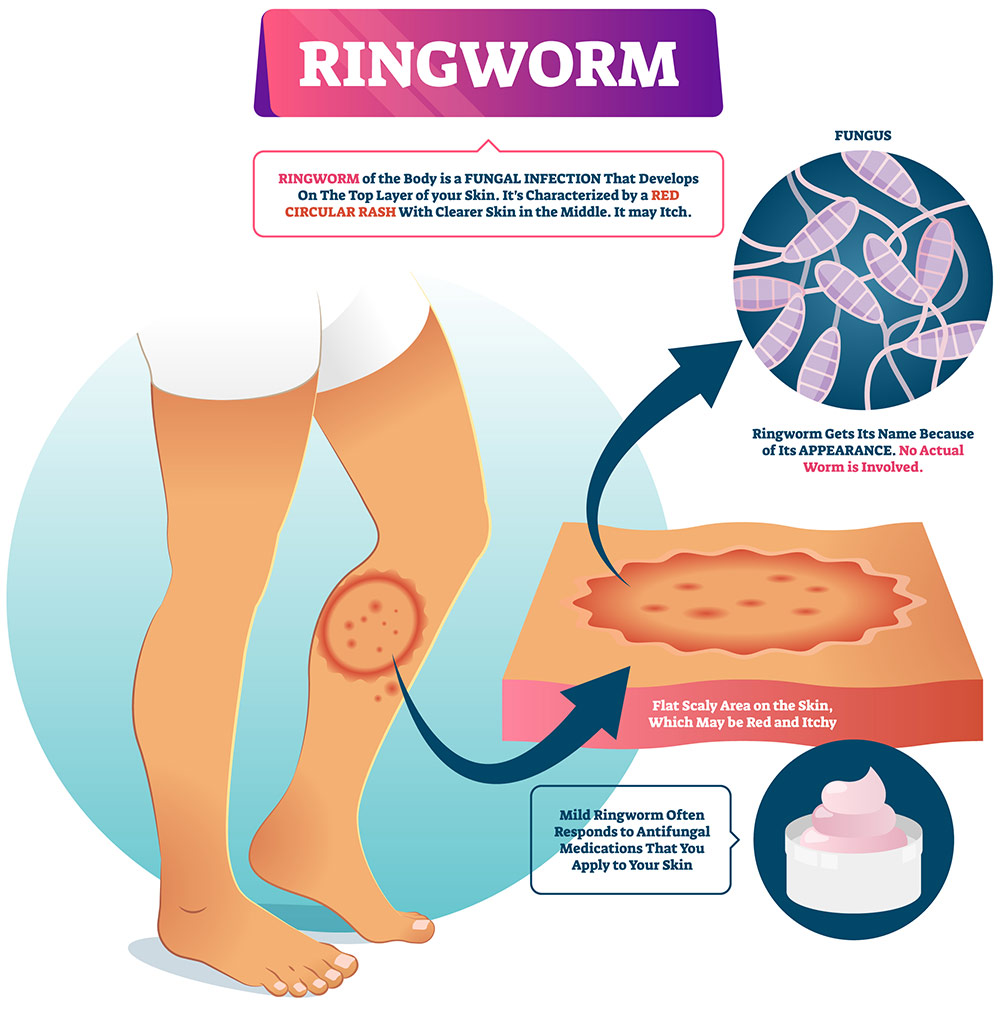
How can I prevent ringworm in dogs, cats and humans?
There are a number of actions that you can take to prevent your pets and your family from catching this fungal infection:
- Regularly cleaning pet blankets and other bedding from your cat or dog’s quarters
- Regularly disposing of any hairs from your pet’s grooming brush
- Removing skin cells and hair from your home by regularly vacuuming the house
- Disinfecting the common areas of the house where your pets tend to live
- Wearing gloves when handling infected animals and washing hands thoroughly afterwards
- Treating all animals in the household, not just those diagnosed with ringworm (if recommended by your vet)
Bear in mind that the ringworm fungus can remain infectious in the environment and re-infection may occur for some considerable time later. It is reported that the fungal spores may remain dormant on combs, brushes, food bowls, furniture, bedding, carpets and other surfaces for up to 18 months.
Additionally, some animals may have ringworm fungi present in their hair or skin without showing any clinical signs of disease. These dogs or cats, called ‘asymptomatic carriers’, can spread the fungal infection to other animals or people despite having no obvious skin lesions. Asymptomatic carriers are especially problematic in multi-animal environments such as animal shelters or kennels as they can spread the ringworm fungi to many other animals and people while showing no clinical signs.
Bow Wow Meow Pet Insurance can help protect you and your pet should an unexpected trip to your vet occur.
- Find out more about our dog insurance options
- Find out more about our cat insurance options
- Get an instant online pet insurance quote



